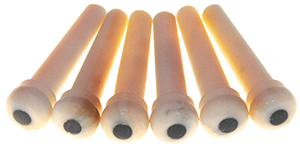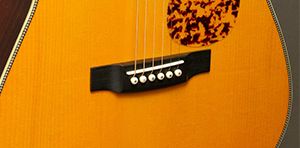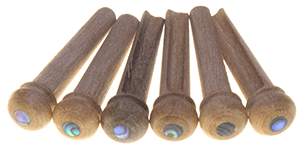
Pinning Down the Right Pins
In our last blog post we discussed the differences between the end pin and strap button on an acoustic guitar, and how some players can get them confused. Today we are moving on to other pins in our ongoing series of blog posts about acoustic guitar hardware found on Martin and Blueridge instruments.
Bridge Pins
Just like how the strap button is often confused for the end pin, so too is the term end pin misused when someone is actually thinking about the bridge pins. To be clear, for those who are new to guitar terminology, we will first make sure you know what we mean when we mention the bridge.
The bridge is the vaguely rectangular object attached to the soundboard, aka the guitar’s top, below the sound hole. Small holes are drilled into the bridge to accept the ball end of the guitar strings. And bridge pins are seated into the holes to secure the strings in place.
Running along the center of the bridge is the slender saddle, which the strings rest upon. The kinetic energy from the played string activates the saddle, which transfers the energy to and through the bridge, and into the soundboard, where it is converted to audible soundwaves, creating musical tone.
Bridges are typically made from wood, like ebony or rosewood, while some are made from other materials, typically synthetic stand-ins for wood. Most modern acoustic guitars have a belly bridge, with an extension behind the bridge pins, introduced in the mid-twentieth century to better withstand the tension brought to bear on the guitar’s top by steel strings, which became popular in the 1920s. Example guitars with a belly bridge include the Blueridge BR-260 and BR-143 and the Martin DSS-17 Whiskey Sunset and 000-17E Black Smoke.

Fossilized Walrus Ivory pins with Ebony inlay
Guitars made in homage to certain vintage guitars will come with a straight bridge, which has no extension “belly.” These include the Blueridge BR-371 and BR-341 and the Martin DSS-17 Whiskey Sunset and 000-17E Black Smoke. The Blueridge models have the decorative carving on either side of the bridge, which gave rise to the term “pyramid bridge,” which you will hear from time to time when people are discussing guitars from the 1800s and early 1900s.
While these straight bridges are there mainly for cosmetic reasons, the specific size and shape of the bridge can have some influence upon the tone of a particular guitar. But that is a topic for another day.
While the string officially terminates at the saddle, it has been proven that the specific material used to make the bridge pins can have its own subtle influence upon tone. Blueridge and Martin guitars often come with plastic bridge pins, because plastic is inert, meaning it will not shrink or expand with the weather and relative humidity, and because it is less expensive than other materials, which helps reduce the sticker price, if only by a relatively small amount.
Models inspired by vintage instruments will sometimes come with bridge pins made of wood or bone. Both options are popular as an aftermarket upgrade, and readily available for sale here at Maury’s Music. But there still more options when it comes to bridge pins.

The Blueridge BR-260 has a belly bridge
Bone bridge pins are by far the most popular and Maury’s Music stocks them with various cosmetic enhancements. Compared to plastic bins, bone pins can add definition and increase high-end brilliance.
Alternatives to bone include bridge pins made from fossilized mammoth and walrus ivory and walrus jawbone that have a similar tonal effect but help fundamental notes sound a little less bright than bone pins. And the walrus jawbone pins have their own unique look, similar to flecked marble.
Ebony bridge pins, conversely, can reduce high-end shrillness, and add a bit of warmth to the overall voice. Pins made from jet black water buffalo horn look like polished ebony, but provide different tonal influence that has transparent clarity and a noticeable increase in volume.
But no pins provide the sort of increased volume and sustain as the Lux brand pins from Martin. These marvels of modern science are made from a metallic glass developed at CalTech, and sold under the name Liquidmetal.
And that is just some of the material used to make bridge pins. That all being said, the tonal influence of bridge pins is rather small and subtle compared to the type of tonewoods used to make a guitar, or the material of the saddle and the bridge. But all such things play their part in the symphonic tone of a fine acoustic guitar.

Persimmon pins with Abalone inlay
Our friend Spoon Phillips ordered a custom guitar from Maury which we found so impressive that we offered identical guitars for sale as a limited edition. Since it was based on Vintage Style 21 from the 1930s, Spoon’s guitar came with ebony bridge pins. But it was also made with Guatemalan rosewood back and sides and an Adirondack spruce top. Spoon felt the voice was so dark and rich that “it was quite inky in the undertone of the low-mids and bass,” so he started experimenting with bridge pins of other materials.
Ultimately Spoon chose wooden bridge pins made of persimmon. “They gave me the definition I wanted down in that smoky rosewood undertone and in those glorious high Adirondack/rosewood harmonics.” And if you like the way they look and are looking to tweak the sound of your favorite guitar in a similar matter, give persimmon bridge pins a try!
The humble bridge pin is often taken for granted, but can provide an easy way to customize the look and sound of an acoustic guitar for not a lot money or effort.